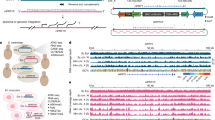Abstract
We have developed a system for stable germline transformation in the silkworm Bombyx mori L. using piggyBac, a transposon discovered in the lepidopteran Trichoplusia ni. The transformation constructs consist of the piggyBac inverted terminal repeats flanking a fusion of the B. mori cytoplasmic actin gene BmA3 promoter and the green fluorescent protein (GFP). A nonautonomous helper plasmid encodes the piggyBac transposase. The reporter gene construct was coinjected into preblastoderm eggs of two strains of B. mori. Approximately 2% of the individuals in the G1 broods expressed GFP. DNA analyses of GFP-positive G1 silkworms revealed that multiple independent insertions occurred frequently. The transgene was stably transferred to the next generation through normal Mendelian inheritance. The presence of the inverted terminal repeats of piggyBac and the characteristic TTAA sequence at the borders of all the analyzed inserts confirmed that transformation resulted from precise transposition events. This efficient method of stable gene transfer in a lepidopteran insect opens the way for promising basic research and biotechnological applications.
This is a preview of subscription content, access via your institution
Access options
Subscribe to this journal
Receive 12 print issues and online access
$209.00 per year
only $17.42 per issue
Buy this article
- Purchase on Springer Link
- Instant access to full article PDF
Prices may be subject to local taxes which are calculated during checkout




Similar content being viewed by others
References
Rubin, G.M. & Spradling, A.C. Genetic transformation of Drosophila with transposable element vectors. Science 218, 348–353 (1982).
O'Brochta, D.A. & Atkinson, P.W. Transposable elements and gene transformation in non-drosophilid insects. Insect Biochem. Mol. Biol. 26, 739–753 (1996).
Loukeris, T.G., Livadaras, I., Arca, B., Zabalou, S. & Savakis, C. Gene transfer into the medfly, Ceratitis capitata , with a Drosophila hydei transposable element. Science 270, 2002–2005 ( 1995).
Handler, A.M., MacCombs, S.D., Fraser, M.J. & Saul, S.H. The lepidopteran transposon vector, piggyBac, mediates germ-line transformation in the mediterranean fruit fly. Proc. Natl. Acad. Sci. USA. 95, 7520–7525 (1998).
Coates, C.J., Jasinskiene, N., Miyashiro, L. & James, A.A. Mariner transposition and transformation of the yellow fever mosquito, Aedes aegypti. Proc. Natl. Acad. Sci. USA 95, 3748– 3751 (1998).
Jasinskiene, N. et al. Stable transformation of the yellow fever mosquito Aedes aegypti, with the hermes element from the housefly. Proc. Natl. Acad. Sci. USA 95, 3743– 3747 (1998).
Lozovskaya, E.R., Nurminsky, D.I., Hartl, D.L. & Sullivan, D.T. Germline transformation of Drosophila virilis mediated by the transposable element hobo. Genetics 142, 173– 177 (1995).
Lohe, A.R. & Hartl, D.L. Germline transformation of Drosophila virilis with the transposable element mariner. Genetics 143, 365–374 ( 1996).
Gomez, S.P. & Handler, A.M. A Drosophila melanogaster hobo-white (+) vector mediates low frequency gene transfer in D. virilis with full interspecific white (+) complementation. Insect Mol. Biol. 6, 165–171 ( 1997).
Nagaraju, J., Klymenko, V. & Couble, P. In Encyclopedia of genetics (ed. Reeves, E.) (Fitzroy Dearborn, London, UK; In press).
Yamao, M. et al. Gene targeting in the silkworm by use of a baculovirus. Genes Dev. 13, 511–516 ( 1999).
Cary, L.C. et al. Transposon mutagenesis of baculoviruses: analysis of Trichoplusia ni transposon IFP2 insertions within the FP-locus of nuclear polyhedrosis viruses. Virology 172, 156– 69 (1989).
Wang, H.H. & Fraser, M.J. TTAA serves as the target site for the TFP3 lepidopteran transposon insertions in both nuclear polyhedrosis virus and Trichoplusia ni genomes. Insect Mol Biol. 1, 109–116 ( 1993).
Robertson, H.M. & Asplund, M.L. Bmmar1: a basal lineage of the mariner family of transposable elements in the silkworm moth Bombyx mori. Insect Biochem. Mol. Biol. 26, 945–954 (1996).
Mounier, N. & Prudhomme, J.C. Differential expression of muscle and cytoplasmic actin genes during development of Bombyx mori. Insect Biochem. 21, 523–533 (1991).
Mangé, A., Julien, E., Prudhomme, J.C. & Couble, P. A strong inhibitory element down-regulates SRE-stimulated transcription of the A3 cytoplasmic actin gene of Bombyx mori. J. Mol. Biol . 265, 266–274 ( 1997).
Kanda, T. & Tamura, T. Microinjection system into the early embryo of the silkworm, Bombyx mori, by using air pressure. Bulliten of the National Institute of Sericultural and Entomological Science 2, 32–46 (1991 ).
Acknowledgements
We thank Marie-Andrée Guérin, Valérie Carraro, Seo Kazuko, and Yamazaki Hiroko for technical assistance, and Hervé Bossin and Yukuhiro Kenji for their help. We also thank Paul Brey and Charlie Roth for editorial help. The group in Tsukuba was supported by the Japanese MAFF. The group in Villeurbanne was supported by the CNRS and the French MENRT and the group in La Mulatière by the INRA; both also received support from the Europe Union (Contract n° CI1*CT94-0092) and the DRET (Contract n° 95/099).
Author information
Authors and Affiliations
Corresponding author
Rights and permissions
About this article
Cite this article
Tamura, T., Thibert, C., Royer, C. et al. Germline transformation of the silkworm Bombyx mori L. using a piggyBac transposon-derived vector. Nat Biotechnol 18, 81–84 (2000). https://doi.org/10.1038/71978
Received:
Accepted:
Issue Date:
DOI: https://doi.org/10.1038/71978
This article is cited by
-
Microstructure of the silk fibroin-based hydrogel scaffolds derived from the orb-web spider Trichonephila clavata
Applied Microscopy (2024)
-
Differential expression of ITP and ITPL indicate multiple functions in the silkworm Bombyx mori
Cell and Tissue Research (2023)
-
Stable transformation of fluorescent proteins into Nosema bombycis by electroporation
Parasites & Vectors (2022)
-
Ectopic expression of sericin enables efficient production of ancient silk with structural changes in silkworm
Nature Communications (2022)
-
Development of a filter device for the prevention of aquatic bacterial disease using a single-chain variable fragment (scFv)-conjugated affinity silk
Scientific Reports (2022)



